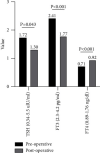Diagnosis and Treatment of Nonfunctioning Pituitary Adenomas with Thyroid Disorders
- PMID: 37020857
- PMCID: PMC10070024
- DOI: 10.1155/2023/2846601
Diagnosis and Treatment of Nonfunctioning Pituitary Adenomas with Thyroid Disorders
Abstract
Objective: Patients with nonfunctioning pituitary adenoma (NFPA) can present with different types of thyroid disorders, which are easily misdiagnosed or missed and can even result in serious clinical consequences. This study was to summarize the different types of thyroid disorders in patients with NFPA with the aim of providing references for the diagnosis and treatment of such patients.
Materials and methods: The data of pituitary adenoma (PA) patients who underwent surgical treatment at Xuanwu Hospital, Capital Medical University, from 2017 to 2021 were retrospectively analyzed, and NFPA patients with preoperative thyroid disorders were screened out to analyze their imaging, endocrine, treatment, and prognosis data. Also, thyroid disorders were classified to summarize diagnostic methods and treatment principles for different types of thyroid disorders.
Results: A total of 399 NFPA patients were included in this study, of which 67 (16.8%) had thyroid disorders before surgery. Fifty-four patients had (13.5%) central hypothyroidism (CH) caused by NFPA and were treated with levothyroxine (L-T4) supplementation before and after operation. Eleven patients (2.8%) had primary hypothyroidism and were treated with L-T4 during the perioperative period, and long-term treatment of primary hypothyroidism was provided after surgery. Two NFPA patients (0.5%) were combined with primary hyperthyroidism and treated with medication for primary hyperthyroidism after tumor resection.
Conclusion: Thyroid disorders are relatively common in patients with NFPA, but are difficult to be diagnosed due to their different types. CH is the most common type of thyroid disorder, which requires aggressive L-T4 supplementation during the preoperative period. The primary disease of the thyroid gland is easily missed when NFPA is combined with primary hypothyroidism or primary hyperthyroidism, and the thyroid function test results require to be analyzed carefully for continued treatment for thyroid disease after resection of the NFPA.
Copyright © 2023 Xu Wang et al.
Conflict of interest statement
The authors declare that they have no conflicts of interest.
Figures
Similar articles
-
Central Hypothyroidism Related to Pituitary Adenomas: Low Incidence of Central Hypothyroidism in Patients With Acromegaly.J Clin Endocrinol Metab. 2019 Oct 1;104(10):4879-4888. doi: 10.1210/jc.2019-00466. J Clin Endocrinol Metab. 2019. PMID: 31188431
-
Clinical Characteristics and Postoperative Recovery of Hypopituitarism in Patients with Nonfunctional Pituitary Adenoma.World Neurosurg. 2019 Jun;126:e1183-e1189. doi: 10.1016/j.wneu.2019.03.062. Epub 2019 Mar 14. World Neurosurg. 2019. PMID: 30880207
-
Digital analysis of hormonal immunostaining in pituitary adenomas classified according to WHO 2017 criteria and correlation with preoperative laboratory findings.Neurosurg Focus. 2020 Jun;48(6):E12. doi: 10.3171/2020.3.FOCUS2039. Neurosurg Focus. 2020. PMID: 32480373
-
MANAGEMENT OF ENDOCRINE DISEASE: Present and future perspectives for medical therapy of nonfunctioning pituitary adenomas.Eur J Endocrinol. 2017 Sep;177(3):R113-R124. doi: 10.1530/EJE-17-0216. Epub 2017 May 3. Eur J Endocrinol. 2017. PMID: 28468768 Review.
-
The natural history of non-functioning pituitary adenomas: A meta-analysis of conservatively managed tumors.J Clin Neurosci. 2022 Jan;95:134-141. doi: 10.1016/j.jocn.2021.12.003. Epub 2021 Dec 10. J Clin Neurosci. 2022. PMID: 34929637 Review.
Cited by
-
Radiological evolution of pituitary hyperplasia in primary hypothyroidism and its differentiation from nonfunctioning pituitary adenoma coexisting with primary hypothyroidism.Endocrine. 2024 Oct;86(1):358-368. doi: 10.1007/s12020-024-03983-1. Epub 2024 Aug 8. Endocrine. 2024. PMID: 39117777
References
LinkOut - more resources
Full Text Sources



